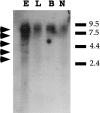A lobster phospholipase C-beta that associates with G-proteins in response to odorants
- PMID: 10366622
- PMCID: PMC6782656
- DOI: 10.1523/JNEUROSCI.19-12-04881.1999
A lobster phospholipase C-beta that associates with G-proteins in response to odorants
Abstract
A cDNA clone encoding a protein of 1116 amino acids with significant homology to beta-isoforms of phospholipase C was isolated from lobster olfactory organ cDNA libraries and named lobPLCbeta. This cDNA hybridized predominantly to a 9 kb transcript in RNA from olfactory organ, pereiopod, brain, and eye-eyestalk and to several smaller minor transcripts only in eye-eyestalk. An antiserum raised to the C terminus of lobPLCbeta detected immunoreactivity in a single 130 kDa band in olfactory aesthetasc hairs, olfactory organ, pereiopod, dactyl, and brain. In eye-eyestalk this 130 kDa band was abundant, and minor bands of 100, 79, and 57 kDa also were detected. In cross sections of the aesthetasc hairs, immunoreactivity was detected in the outer dendritic segments of the olfactory receptor neurons, the site of olfactory transduction. A complex odorant caused lobPLCbeta immunoreactivity to increase in membrane fractions and decrease in soluble fractions of homogenates of aesthetasc hairs. The odorant also increased the amount of lobPLCbeta in immunoprecipitates of Galphaq and Gbeta from homogenates of aesthetasc hairs. These results support the conclusion that lobPLCbeta mediates olfactory transduction.
Figures







Similar articles
-
Molecular cloning of a lobster G alpha(q) protein expressed in neurons of olfactory organ and brain.J Neurochem. 1997 Jun;68(6):2248-54. doi: 10.1046/j.1471-4159.1997.68062248.x. J Neurochem. 1997. PMID: 9166716
-
Lobster G-protein coupled receptor kinase that associates with membranes and G(beta) in response to odorants and neurotransmitters.J Comp Neurol. 1999 Dec 27;415(4):449-59. doi: 10.1002/(sici)1096-9861(19991227)415:4<449::aid-cne3>3.0.co;2-u. J Comp Neurol. 1999. PMID: 10570455
-
Molecular cloning and characterization of a lobster G alphaS protein expressed in neurons of olfactory organ and brain.J Neurochem. 1997 Nov;69(5):1793-800. doi: 10.1046/j.1471-4159.1997.69051793.x. J Neurochem. 1997. PMID: 9349521
-
Assay for G protein-dependent activation of phospholipase C beta using purified protein components.Methods Mol Biol. 2004;237:67-75. doi: 10.1385/1-59259-430-1:67. Methods Mol Biol. 2004. PMID: 14501039 Review.
-
Phosphoinositide second messengers in olfaction.Comp Biochem Physiol B Biochem Mol Biol. 1996 Mar;113(3):451-9. doi: 10.1016/0305-0491(95)02040-3. Comp Biochem Physiol B Biochem Mol Biol. 1996. PMID: 8829799 Review.
Cited by
-
Ionotropic crustacean olfactory receptors.PLoS One. 2013;8(4):e60551. doi: 10.1371/journal.pone.0060551. Epub 2013 Apr 3. PLoS One. 2013. PMID: 23573266 Free PMC article.
-
Single cell transcriptomes reveal expression patterns of chemoreceptor genes in olfactory sensory neurons of the Caribbean spiny lobster, Panulirus argus.BMC Genomics. 2020 Sep 22;21(1):649. doi: 10.1186/s12864-020-07034-7. BMC Genomics. 2020. PMID: 32962631 Free PMC article.
-
Adenophostin A and imipramine are two activators of the olfactory inositol 1,4,5-trisphosphate-gated channel in fish olfatory cilia.Eur Biophys J. 2003 May;32(2):106-12. doi: 10.1007/s00249-002-0271-x. Epub 2003 Jan 23. Eur Biophys J. 2003. PMID: 12734698
-
Phosphoinositide 3-kinase mediated signaling in lobster olfactory receptor neurons.J Neurochem. 2010 Apr;113(2):341-50. doi: 10.1111/j.1471-4159.2010.06597.x. Epub 2010 Feb 2. J Neurochem. 2010. PMID: 20132480 Free PMC article.
References
-
- Ache BW. Toward a common strategy for transducing olfactory information. Semin Cell Biol. 1994;5:55–65. - PubMed
-
- Blank JL, Brattain KA, Exton JH. Activation of cytosolic phosphoinositide phospholipase C by G-protein βγ subunits. J Biol Chem. 1992;267:23069–23075. - PubMed
-
- Bloomquist BT, Shortridge RD, Schneuwly S, Perdew M, Montell C, Steller H, Rubin G, Pak WL. Isolation of a putative phospholipase C gene of Drosophila, norpA, and its role in phototransduction. Cell. 1988;54:723–733. - PubMed
Publication types
MeSH terms
Substances
Grants and funding
LinkOut - more resources
Full Text Sources
